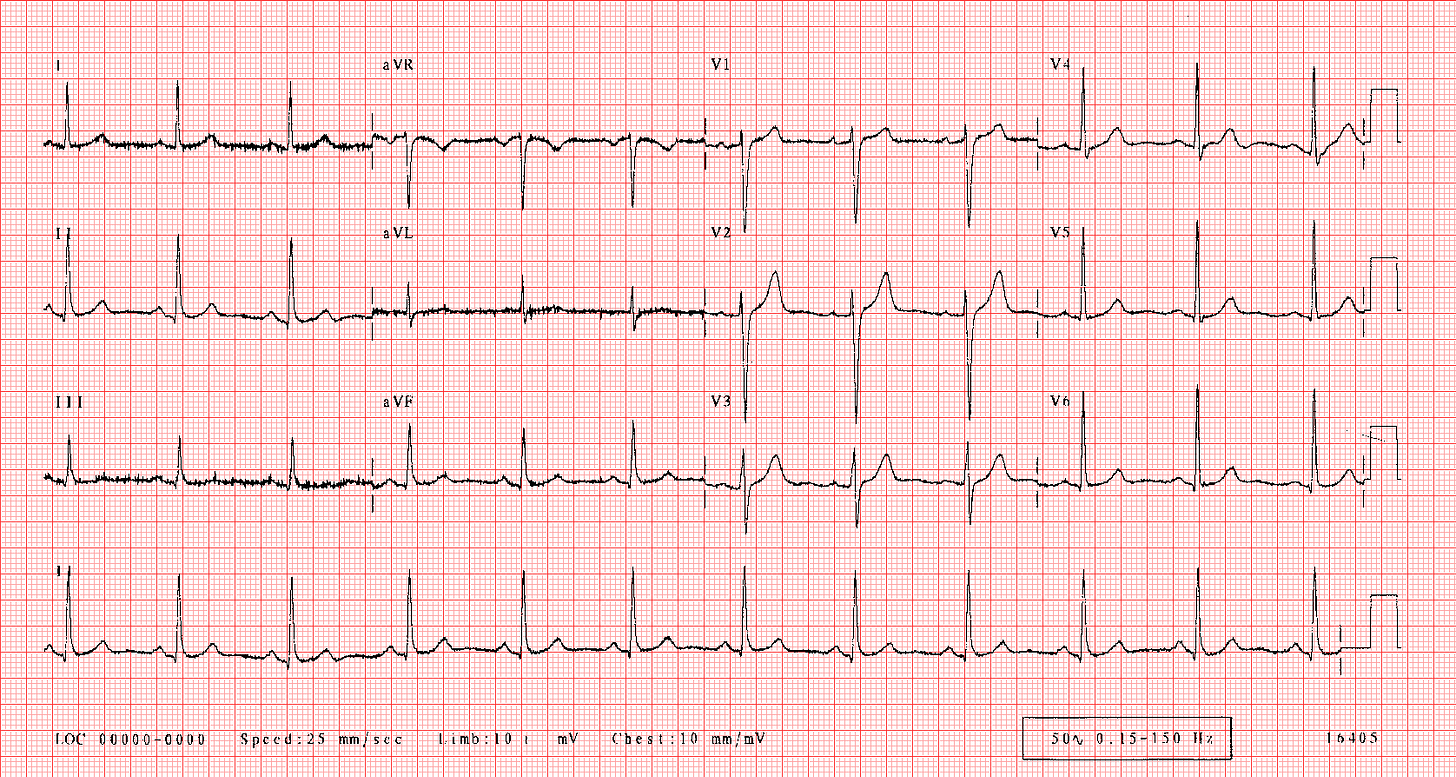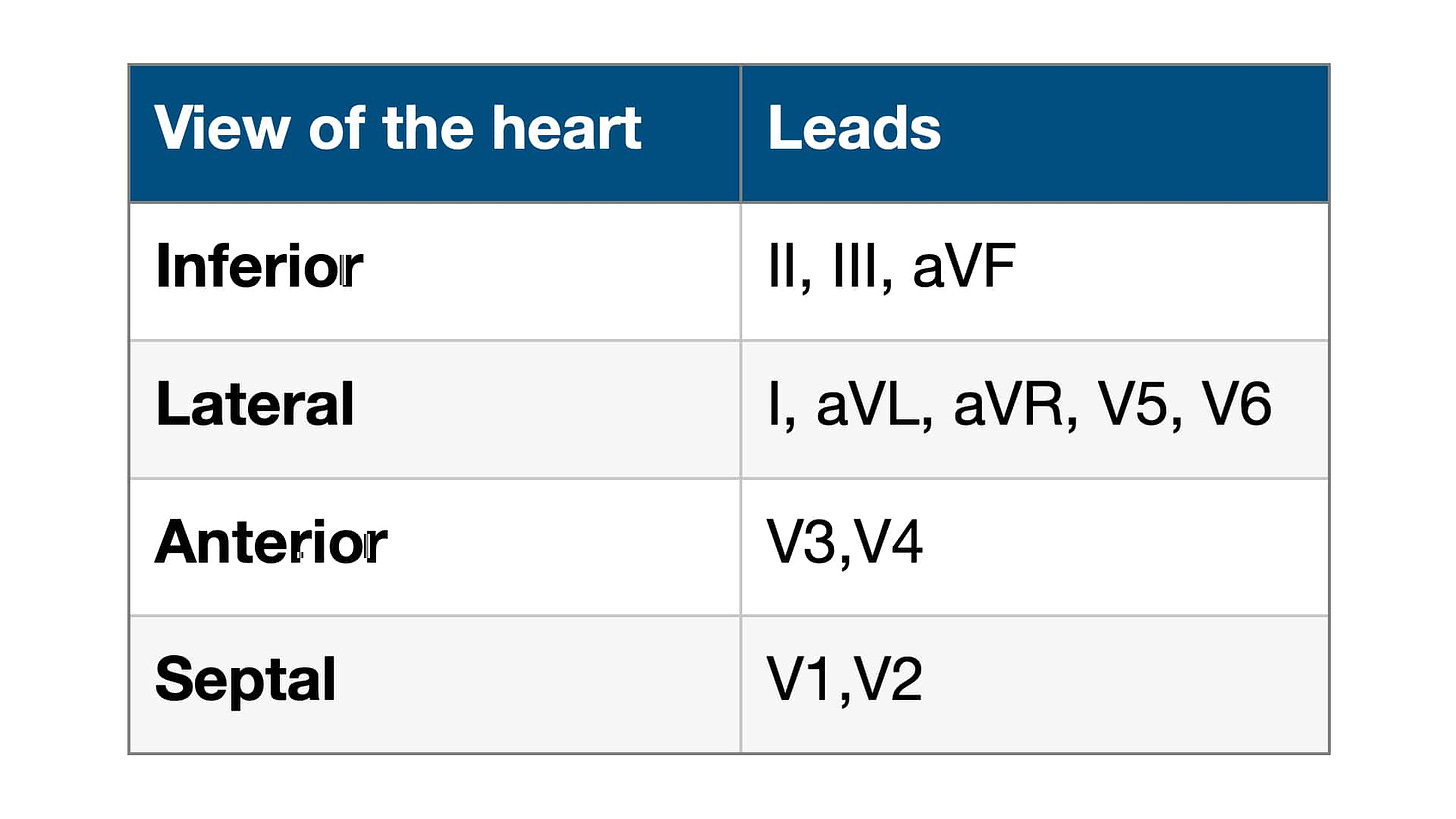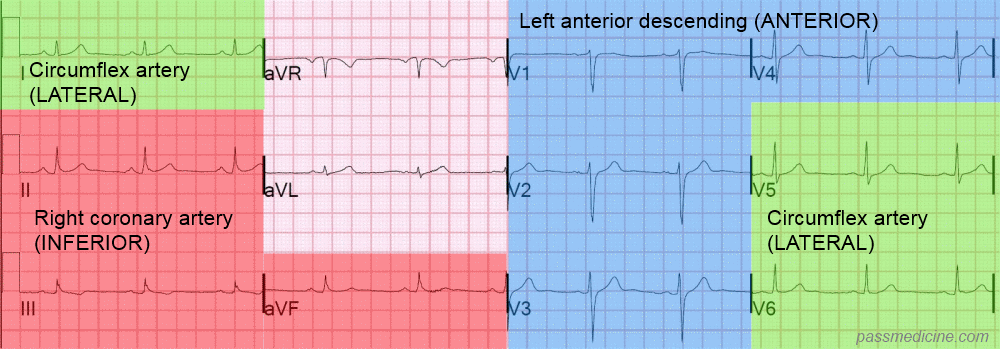Overview:
It’s difficult to cover everything to do with ECGs in one newsletter but what I am going to do today is either i) remind you of or ii) introduce you to, what each line on the ECG represents in terms of what area of the heart it is and which blood supply it is.
Most ECGs are carried out with 12 leads. Therefore, there should be 12 different titles on an ECG sheet that you see.
As you can see, the leads are referred to as Lead I, II, III, aVR, aVL, aVF, V1, V2, V3, V4, V5, V6
If you actually count the headings, there are 13, but look closer, the bottom long line, is just the longer version of lead II. This lead is known as the rhythm lead (This is the lead that is used to check for aFib, Aflutter, Heartblocks etc - little fun fact).
There is a lot of information about what each lead represents and what each lead is looking at, however, the main focus of today is to show you which coronary arteries the leads correlate with (that’s a mouthful isn’t it? or is it just me?) and which surface of the heart the lead is looking at.
What I’m trying to say is, if there was something wrong in lead V6, what does that tell you? That there is a problem in the entire heart? No.
It just indicates that a certain area of the heart might have some problems and in an ECG, the “area” are coronary arteries.
What surface is the lead telling you about?
Let’s start with the surfaces:
So this is quite straightforward. Inferior literally means bottom of the heart, lateral means to the side, anterior means in front and septal means at the septum.
There is no otherway around this but to memorise these leads. This is how I do it. I just remember the groups. So for II,III, aVF - because of the F I remember inFerior.
For I, aVL, aVR, V5 and V6 - because of the L, I remember Lateral.
The rest is just down to memory.
Which coronary arteries are the leads referring to?
Now, the extra bit, is remembering which coronary arteries these refer to.
Inferior leads (II, III, aVF) - Right Coronary Artery (RCA)
Lateral leads (I, aVL, V5, V6) - Left Circumflex (LCx)
Anterior leads (V3, V4) - Left Anterior Descending Artery (LAD)
Septal (V1, V2) - Left Anterior Descending Artery
(Anterior and septal are usually referred to as together as anterolateral. They are both provided by the LAD)
So if you get called on by the Doctor on the ward and they say, this patient has just suffered a heart attack and their ECG showed an ST elevation in leads II, III and aVF.
What area of the heart is this?
Which artery/ies are affected?
You should be able to say that this is the inferior side of the heart and that it is the right coronary artery.
Remember, that if there is any changes in one of the leads, check the other leads in the same group to confirm your suspicion, because usually there would be something there too. So if there was an ST elevation in lead II, make sure to check lead III and avF also.
Also remember, that sometimes a heart attack can be anterolateral or anteroseptal etc.. so in this case, it is two surfaces affected and a combination of arteries or one of the arteries.
Little Quiz: Don’t cheat
Fill in the blanks:
Lateral leads include: I, aVL, V5, _
Inferior leads include: II, _ , aVF
Anterior leads include: V3, _
Septal leads include: V1, _
Heart attack in II, III, aVF means what surface of the heart is affected?
Heart attack in V3, V4 and I, aVL, V5 and V6 means what surface is affected?
If a patient is known to have an Inferior heart attack, which blood supply is affected?
If a patient is known to have a anterolateral (anterior + lateral) heart attack, which blood supply is affected?
How did you do? Let me know in the comments below :)
Song of the week:
Video of the week:
Want to show support?
If you enjoy these newsletters or/and my youtube channel and want to show support, then you can buy me a coffee here: https://www.buymeacoffee.com/HabibM
🚶🏻♂️ About me:
My name is Habib and I am a 5th-year Medical student currently in Cyprus. I grew up in Tanzania (Hakuna Matata is from the local language of my country and the second tallest mountain (Kilimanjaro) is found there).
I’m just a regular Medical student who enjoys what he does and I like to express my creative side through my youtube channel which you can check out too if you’d like :D
🎥 Subscribe to my youtube here: Youtube
📸 Follow me on Instagram here: Instagram
📱 Follow me on Twitter here: Twitter
🔗 Follow me on LinkedIn here: LinkedIn










Loved this post! We just covered ECGs yesterday and this made everything much more clear and easier to remember, thank you!! :)